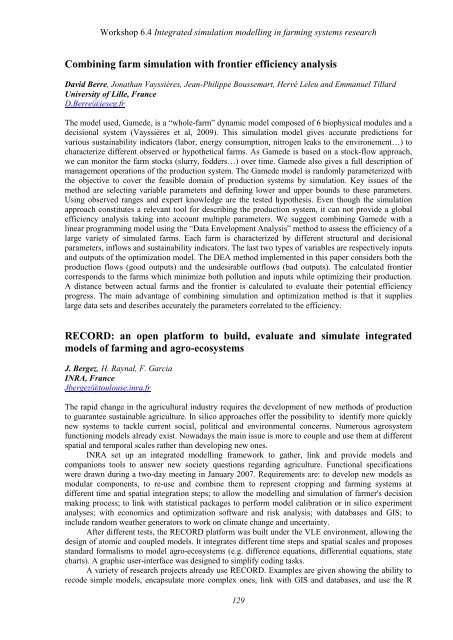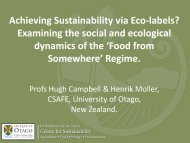Book of Abstract (incl. addendum) - IFSA symposium 2012
Book of Abstract (incl. addendum) - IFSA symposium 2012
Book of Abstract (incl. addendum) - IFSA symposium 2012
Create successful ePaper yourself
Turn your PDF publications into a flip-book with our unique Google optimized e-Paper software.
Workshop 6.4 Integrated simulation modelling in farming systems research<br />
Combining farm simulation with frontier efficiency analysis<br />
David Berre, Jonathan Vayssières, Jean-Philippe Boussemart, Hervé Leleu and Emmanuel Tillard<br />
University <strong>of</strong> Lille, France<br />
D.Berre@ieseg.fr<br />
The model used, Gamede, is a “whole-farm” dynamic model composed <strong>of</strong> 6 biophysical modules and a<br />
decisional system (Vayssières et al, 2009). This simulation model gives accurate predictions for<br />
various sustainability indicators (labor, energy consumption, nitrogen leaks to the environement…) to<br />
characterize different observed or hypothetical farms. As Gamede is based on a stock-flow approach,<br />
we can monitor the farm stocks (slurry, fodders…) over time. Gamede also gives a full description <strong>of</strong><br />
management operations <strong>of</strong> the production system. The Gamede model is randomly parameterized with<br />
the objective to cover the feasible domain <strong>of</strong> production systems by simulation. Key issues <strong>of</strong> the<br />
method are selecting variable parameters and defining lower and upper bounds to these parameters.<br />
Using observed ranges and expert knowledge are the tested hypothesis. Even though the simulation<br />
approach constitutes a relevant tool for describing the production system, it can not provide a global<br />
efficiency analysis taking into account multiple parameters. We suggest combining Gamede with a<br />
linear programming model using the “Data Envelopment Analysis” method to assess the efficiency <strong>of</strong> a<br />
large variety <strong>of</strong> simulated farms. Each farm is characterized by different structural and decisional<br />
parameters, inflows and sustainability indicators. The last two types <strong>of</strong> variables are respectively inputs<br />
and outputs <strong>of</strong> the optimization model. The DEA method implemented in this paper considers both the<br />
production flows (good outputs) and the undesirable outflows (bad outputs). The calculated frontier<br />
corresponds to the farms which minimize both pollution and inputs while optimizing their production.<br />
A distance between actual farms and the frontier is calculated to evaluate their potential efficiency<br />
progress. The main advantage <strong>of</strong> combining simulation and optimization method is that it supplies<br />
large data sets and describes accurately the parameters correlated to the efficiency.<br />
RECORD: an open platform to build, evaluate and simulate integrated<br />
models <strong>of</strong> farming and agro-ecosystems<br />
J. Bergez, H. Raynal, F. Garcia<br />
INRA, France<br />
Jbergez@toulouse.inra.fr<br />
The rapid change in the agricultural industry requires the development <strong>of</strong> new methods <strong>of</strong> production<br />
to guarantee sustainable agriculture. In silico approaches <strong>of</strong>fer the possibility to identify more quickly<br />
new systems to tackle current social, political and environmental concerns. Numerous agrosystem<br />
functioning models already exist. Nowadays the main issue is more to couple and use them at different<br />
spatial and temporal scales rather than developing new ones.<br />
INRA set up an integrated modelling framework to gather, link and provide models and<br />
companions tools to answer new society questions regarding agriculture. Functional specifications<br />
were drawn during a two-day meeting in January 2007. Requirements are: to develop new models as<br />
modular components, to re-use and combine them to represent cropping and farming systems at<br />
different time and spatial integration steps; to allow the modelling and simulation <strong>of</strong> farmer's decision<br />
making process; to link with statistical packages to perform model calibration or in silico experiment<br />
analyses; with economics and optimization s<strong>of</strong>tware and risk analysis; with databases and GIS; to<br />
<strong>incl</strong>ude random weather generators to work on climate change and uncertainty.<br />
After different tests, the RECORD platform was built under the VLE environment, allowing the<br />
design <strong>of</strong> atomic and coupled models. It integrates different time steps and spatial scales and proposes<br />
standard formalisms to model agro-ecosystems (e.g. difference equations, differential equations, state<br />
charts). A graphic user-interface was designed to simplify coding tasks.<br />
A variety <strong>of</strong> research projects already use RECORD. Examples are given showing the ability to<br />
recode simple models, encapsulate more complex ones, link with GIS and databases, and use the R<br />
129











